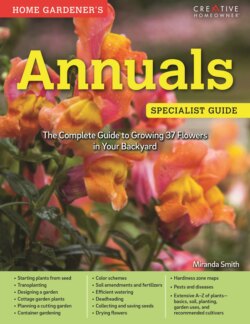Читать книгу Home Gardener's Annuals - Miranda Smith - Страница 9
На сайте Литреса книга снята с продажи.
ANNUAL HARDINESS
ОглавлениеAnnuals are categorized as hardy, tender, or half-hardy according to their tolerance to cool temperatures.
Hardy annuals such as bachelor’s button, calendula, and larkspur grow best in cool temperatures and can withstand some frost and freezing. They are often started from seeds sown directly in the garden. In Zones 7 and colder, gardeners can sow hardy annuals outdoors as soon as the soil can be worked in spring. Some annuals can even be sown the previous fall. In Zones 8 and warmer, gardeners more often sow hardy annuals in fall for flowers in winter or early spring.
Tender annuals such as impatiens, cockscomb, and zinnia are sensitive to cold. In most areas, they are started indoors and transplanted outdoors after the frost-free date, when the soil is warm. An indoor start is particularly important in areas with a short frost-free growing season.
A third category of plants—half-hardy annuals—is accepted by some horticulturists but not by others.
Half-hardy annuals are in between the other two types in terms of hardiness and include marguerite, lobelia, and petunia. Half-hardy plants like cool weather and tolerate a bit of light frost but are damaged by repeated exposure to frost and freezing. Gardeners in all but the warmest climates (Zones 8 to 11) start them early indoors and plant them out when frost danger is past.
